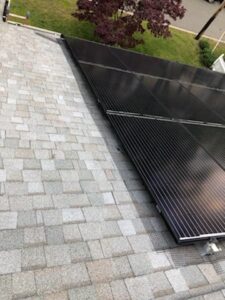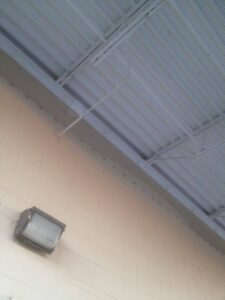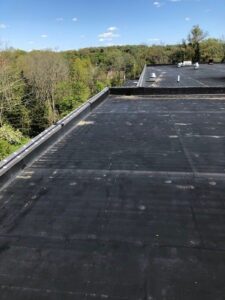Pigeons are a familiar presence in urban life, living close to humans for generations. Once used to transport messages and revered for their remarkable homing abilities, they fly under the radar in urban landscapes until their impacts are felt. Pigeon populations are flourishing because
- They are not picky eaters and will gladly eat what we discard.
- Water is plentiful.
- We’ve built ledges, rooftops, bridges, chimneys, warehouses, and barns where flocks can gather and roost.
- Predators are rare.
While their precense might be ubiquitous, pigeons can damage your house, spread diseases, and impact your business. For both residential and commercial properties, pigeons can be a problem.
What Problems Do Pigeons Cause?
People should consider pigeon control when it becomes apparent pigeons have taken up full-time residence on their property. The occasional pigeon resting on your roof or ledge is not a problem. The signs of a pigeon infestation include nests, pigeon droppings, and damage.
Pigeon Poop
Pigeon poop consists mainly of uric acid, a decay agent. Over time, pigeon poop will decay and deface residential homes and large city buildings alike. Aside from this damage being aesthetically ugly, it does real chemical damage to painted surfaces, stone, metal architectural elements, and bridges. In addition to weakening structures, there are many historical and cultural heritage objects, such as monuments and statues, that need to be preserved.
A healthy diet for a pigeon consists of insects, worms, seeds, and grains. This diet would produce healthy pigeon poop that looks like hard white-brown colored small marbles that might contain a few small feathers. However, pigeons have grown to eat whatever trash they find in the park, on a sidewalk, or in public trash cans on city streets. As a result, much of the pigeon poop we see is white and runny.
It might be hard to imagine any kind of bird poop causing that large of a problem. However, one pigeon creates around 25 pounds of poop per year. If you have only a pair of pigeons roosting on your roof, it may seem inconsequential. But two pigeons won’t stay two pigeons for long. Since pigeons like to congregate in flocks, it will only take 80 pigeons to create one ton of droppings in a relatively short period of time.
Pigeon flocks grow at approximately 30–35% per year. With every egg that hatches, there’s a new pigeon to join the flock.
Disease and Damage
Because pigeons roost in flocks, their poop is not only unsightly but can accumulate quickly on cars, buildings, sidewalks, and lawns, where it is not only nasty but also damaging and unhealthy.
Pigeon poop contains acids that are erosive to both stone and metal, staining and corroding buildings, statues, cars, and more. In cities where large flocks of pigeons congregate, it would not take long for tons of pigeon poop to accumulate and cause floors or roofs to collapse.
Diseases that can be transmitted by pigeon droppings include cryptococcosis, histoplasmosis, and psittacosis. Pigeon droppings cultivate the growth of fungus that contains these diseases. When cleaning dry droppings, the dust created houses the fungus and can be inhaled. Those who have a compromised immune system are at greater risk. These diseases are based in the lungs and can cause pneumonia, flu-like symptoms, and damage to one’s nervous system.
Where Pigeons Cause Problems on Houses
Attics
Deterrent and exclusionary methods can reduce the possibility of pigeons getting inside attics. Making sure you have screens on windows and caps on vents also help. However, pigeons are smart, so even these methods don’t guarantee you won’t find pigeons roosting in your attic. Once inside, it’s best to call in professionals to eradicate them, as injury and disease transmission are not worth the risk. Critter Control uses humane and effective methods and will also repair and clean damage created by pigeons.
Roof & Balcony
Flat surfaces such as your home’s roof or balcony are a perfect landing place for a flock of pigeons. Unlike a roof, where deterrents can be effective, balconies with outdoor furniture and where residents like to spend time cannot be remedied by deterrents without also being a human deterrent. It is at this point that professionals are your best choice for getting rid of pigeons.
Pigeon Problems on Commercial Properties
A pigeon’s natural roosting location is on cliffs or rock ledges. They nest inside or rock crevices or flat ledges. In cities, buildings provide the same ideal conditions for a pigeon. Ledges, signs, roofs, or any elevated surface can be used by pigeons. Some of the most common areas are signs, solar panels, and in warehouses or parking garages.
Store Signs
Store signs, especially those with lights, are a favorite roosting spot for pigeons because they give off heat that pigeons love. Not only can these signs become defaced by the pigeons, but their feces make the signs unsightly, and the sidewalk below becomes a slipping hazard for customers walking by.
Warehouse
It’s difficult to control bird activity in warehouses because it is an environment in which doors are continually opened in the regular activity of doing business. Pigeons roosting on beams and high shelving cause a hazard. Their poop is slippery, and workers are at risk of slipping. In addition, they can become a distraction or create a scare when using machinery and tools.
Solar Panels

Whether you have solar panels on your personal property or a commercial enterprise, chances are pigeons will discover them. Installed on a roof, solar panels have a small gap between the roof and the panel. This empty gap makes a perfect place for pigeons to build their nests out of the sight of predators. Unfortunately, the abundance of droppings on the panels can cause reduced efficiency and costly damage.
Pigeon Control Products
Whether in a residential neighborhood or commercial area, managing pigeon poop takes continual upkeep that costs money. Houses and buildings need to be power-washed and painted more often. Gutters need to be cleaned. Roofing may need to be replaced more frequently. In cities, pigeon complaints in residential areas can result in fines.
Pigeon control products have become a necessary part of your home and building maintenance. Here’s how they work.
Bird Netting
Bird netting hung vertically along the siding of a building will prevent any bird from perching on the surface of a structure. The netting works best on pitched roofs and is relatively invisible. On the downside, it is time-consuming to install and maintain.

Bird Gels
Bird gels are sticky substances that can be spread across structures. The effort it takes for pigeons to get free deters them from landing again. While the gel doesn’t trap pigeons, this method could trap smaller birds unable to set themselves free.

Parallel Wires
Running parallel wires across your structure, whether a house, large building, or shed, will keep pigeons from landing and nesting on the roof. This can be accomplished as a DIY project, but it can be tricky and might best be installed by a professional.
Decoys
Decoys such as plastic owls, reflective disks, or kites with bird images are affordable, simple to employ, and humane methods of discouraging pigeons from landing. The downside is that they work for a short period of time before smart pigeons realize what they are and start ignoring them.
Lasers
Motion-activated lasers flash a piercing light that startles landing pigeons. This is an effective method at first, but like decoys, pigeons get used to them.
Professional Pigeon Control
Safely and effectively controlling pigeons can be quite difficult. Attempting to secure all the nooks and crannies a pigeon can use to roost takes experience, skill, and ingenuity. At Trutech Wildlife Service, we have bird control experts who can effectively get rid of pigeons from your house or commercial building.
We will assess your specific situation and develop a custom solution based on where pigeons are roosting and the severity of the problem. Often, we employ multiple bird control solutions from the list below to make the area inhospitable to pigeons so they go away on their own:
- Install barriers
- Clip and clear roosting branches
- Fixing or adding vent screens and chimney caps
- Installing spikes
- Setting up wires
- Fencing gardens
- Sealing gaps in roofing, sheds, and warehouses


